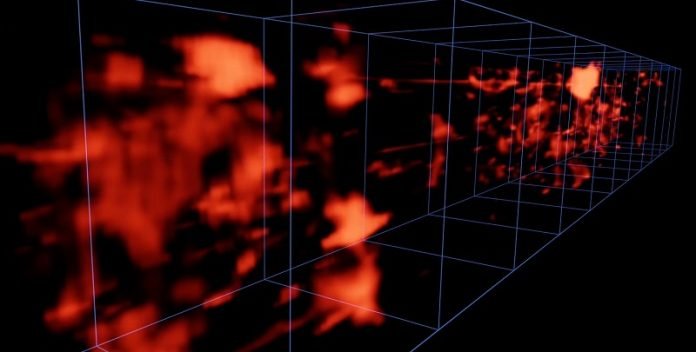
The universe is much like an intricate web, woven with invisible threads connecting galaxies, called the cosmic web.
This web is made of gas streams, serving as life-lines, feeding galaxies with the essential elements they need to birth stars.
For a long time, scientists knew about this web but visualizing it was a challenge due to its faint nature.
However, the Keck Cosmic Web Imager, created by a team led by Caltech’s Christopher Martin, has broken through this barrier, lighting up the dim pathways of the cosmic web for the first time.
Stationed at the W. M. Keck Observatory in Hawaiʻi, this imager has enabled scientists to observe these gaseous filaments that stretch between galaxies, making them visible without the need for bright cosmic objects like quasars to illuminate them.
The newfound capability to visualize the cosmic web offers a powerful insight into the evolution and formation of galaxies.
It allows scientists to trace the distribution of dark matter in the universe.
Dark matter constitutes about 85% of the universe’s matter, but we still don’t know much about it. Christopher Martin’s determination to unveil the entire cosmic web began during his graduate studies, and the detailed imaging procured will fill in the gaps in our understanding of the cosmos.
To observe the cosmic web directly, scientists use spectrometers, which identify hydrogen gas, the main component of the cosmic web, by dispersing light into different wavelengths.
This process reveals the Lyman alpha line, the strong emission line of hydrogen gas. The KCWI, developed to detect faint Lyman alpha signatures, captures two-dimensional images at different wavelengths.
Each wavelength corresponds to different distances due to the universe’s expansion, allowing scientists to stack these images together, constructing a three-dimensional map of the cosmic web.
However, the delicate glow of the cosmic web is prone to blending with the surrounding light, such as the atmospheric glow, zodiacal light, and the light from our galaxy. To overcome this, Martin devised a method to subtract this conflicting background light by comparing two different sky patches.
This innovative technique helped to isolate and visualize the elusive structures of the cosmic web, paving the way for extensive studies about the universe.
The imager’s new segment, the Keck Cosmic Reionization Mapper (KCRM), extends its vision into the red or longer-wavelength portion of the visible spectrum, allowing researchers to peer even further back in time.
This development has aroused excitement in the scientific community, fueling anticipation about the knowledge it will unravel regarding distant filaments and the era when the first stars and black holes came into existence.
In an artistic and scientific fusion, Martin collaborated with artist Matt Schumaker to convert cosmic web data into music.
This project, a tribute to astronaut Michael Anderson who lost his life in the Space Shuttle Columbia accident in 2003, interprets the masses of the filaments as musical frequencies around the note middle C.
This study, featured in Nature Astronomy, is a pioneering stride, funded by the National Science Foundation and Caltech.
It opens up avenues for exploring the universe in unprecedented ways, allowing us to understand the invisible bridges connecting the cosmic bodies and perhaps solve the mysteries of the unseen entities like dark matter.
In simpler terms, imagine the universe as a massive, intricate puzzle, where each piece is a galaxy, connected by invisible strings, or filaments.
These connections are vital; they are the pathways through which galaxies receive the building blocks needed to create stars.
Now, thanks to advanced technology, scientists can see these invisible strings, opening doors to countless discoveries about our universe, and presenting us with beautiful cosmic music inspired by these hidden threads of the cosmos.
Follow us on Twitter for more articles about this topic.



